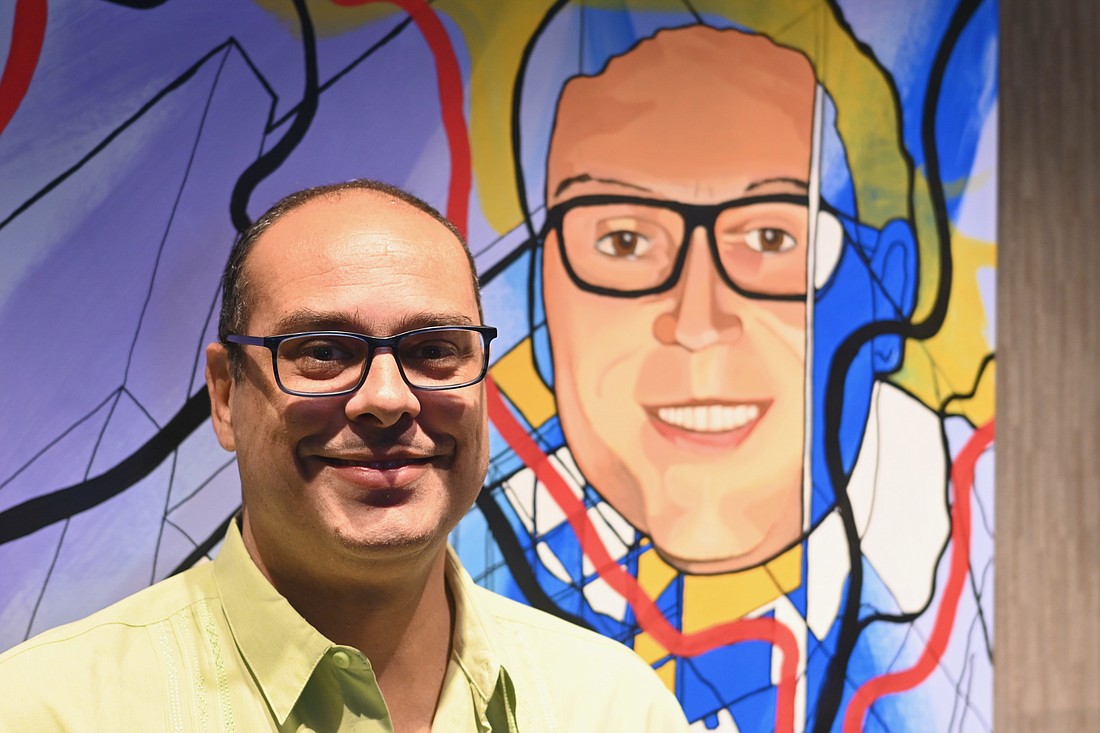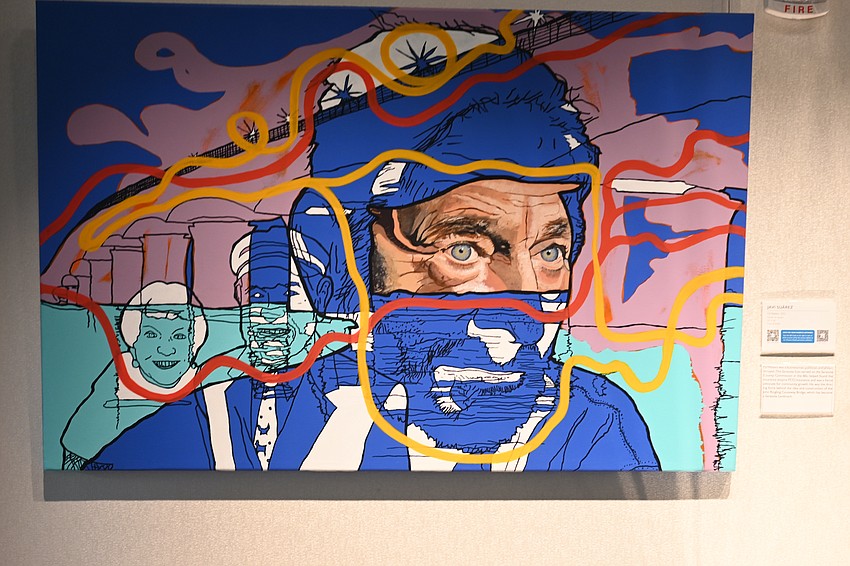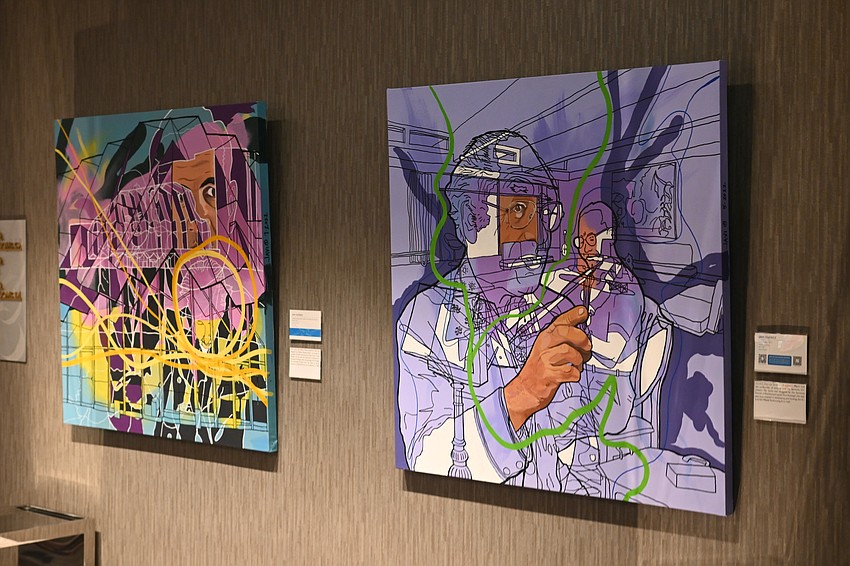- November 22, 2024
-
-
Loading

Loading

It’s a history lesson, a love letter to Sarasota and a layered statement of artistic intent. Javi Suárez grew up in this town, having moved to Sarasota from Puerto Rico as a 10-year-old, and he moved back here to pursue his career as an architect and his passion as an artist.
Now, in his first exhibit at Art Ovation, he’s making Sarasota iconic.
Suárez has taken on nothing less than the history of Sarasota and the people who helped make it the place it is today, and he says it was important for him to depict not just titans that loom large in the public consciousness but also those who have been overlooked.
“There’s icons within the community that everybody knows about that; we have represented the John Ringlings and Marie Selbys,” says Suárez of his series of paintings. “Then there's other individuals that either have not had the spotlight shined on them enough, or sometimes not at all on purpose. I wanted to make sure that the work represented equally some icons that were male, female, indigenous, Latin, African-American. So that's kind of where it started.”
Suárez, in making this collection, had to be not just an artist; he had to be a historian and a curator. He wanted to tell the entire sweep of Sarasota’s history, but he had to find a way to do it in just 14 large-scale paintings. And he started at the place that’s closest to home.
There’s his dad, Javier Suárez, one of the first Latin-American architects registered in Sarasota County. Today, father and son work together at a family architecture firm, and the younger Suárez says he had to hide the fact that he was trying to paint his dad.
“He’s proud. But my dad’s not very emotive,” says the artist of his father seeing himself on canvas. “He wouldn't show it. He wouldn't admit it. But I found out through my mom.”
Other prominent Sarasotans depicted in the series include Dr. Eugenia Clarke, the founder of the organization that later became the Mote Marine Laboratory, and Dr. Manuel Gordillo, an infectious disease specialist helping the community bridge the pandemic.

Gil Waters, a local businessman and philanthropist who was the driving force behind the John Ringling Causeway Bridge, is depicted with his striking blue eyes standing out amid the brush strokes.
Suárez says that he doesn’t consider himself a portrait painter; he’s a storyteller. Each of his paintings has not just a stylized likeness of the iconic figure represented, it also has a pop art expressionistic illustration of things close to that person’s heart.
For instance, there’s orchids and trees and an illustration of people getting married in the Marie Selby piece, and Waters floats over the bridge he helped build in the background.
Suárez says his style developed over decades, but it’s rooted in his fascination with jazz and improvisation but also in his own identity.
“My family lineage is very mixed,” he says. “Being from Puerto Rico, you got one fork of the family that’s the colonizers and then another fork of the family that's the colonized. So there's a push and pull. I was trying to figure out sort of where I fit. These ideas of overlapping images and the being literally in between those ideas started percolating in the head and developing into the visual language.”
When making the list of people to depict, Suárez says he consulted Jetson Grimes, who runs the Newtown Historical Gallery on Osprey Avenue. That’s how he learned about figures like Mary Emma Jones, the leader of the Colored Women’s Civic Club, who pushed for desegregation of local beaches and other civil rights.

Jones rests on the wall near Newtown’s own Buck O’Neil, who was posthumously elected to Major League Baseball’s Hall of Fame in 2002. In the other direction, there’s Civil Rights movement leaders John Rivers and Dr. Ed James keeping Jones company again.
There are other interesting partnerships; there’s a painting for John Ringling and one for Mable Ringling side-by-side, and another for former Sarasota mayor David Cohen sitting right next to a painting that represents a building that he helped inspire the city to build.
“He was a lover of the arts. He was a gifted violinist. And he became one of the co-founders of what would eventually become Sarasota Orchestra,” says Suárez before explaining some of the painting’s hidden detail. “He had a famous architect, Paul Rudolph, design his house, and he designed it with this pit in the middle so they could sit around and play together. And then when he became mayor, he was fighting to bring a performing arts center to Sarasota, so he was one of the spearheads to have the Van Wezel built.”

The Cohen painting — and also the one representing the Van Wezels — have tinges of purple.
But Suárez isn’t only going for realism. He calls his style rational expressionism because of the way it exists between two styles.
He wants you to spend a time in front of the work pondering every detail, and he wants you to find new things every time you look.
Suárez, who says his favorite artist is Basquiat, says that his layered images came from artistic practice. He would project images from his travels on a screen, and then he’d try to draw them. Then he’d try to draw another image, and slowly they melded together.
The faces may stand out to you. But they come after all the other detail is sketched in and fleshed out.
“The faces are kind of the last ones to get painted,” he says.
"It’s a layered process.”
Suárez knows that he can never fully account for the history of Sarasota with 14 paintings, and he says he’s not against coming back and revisiting the topic at some point.
But he also feels that it’s important to honor the town where he grew up warts and all, to depict its champions who built buildings and also the people who helped rebuild its society.
“I’m a big believer that your ancestors and the history of a place makes people who they are,” says Suarez of his exhibit. “Obviously, the city and Sarasota County keep evolving. Because it's a beautiful place with beautiful people and it has lots of cultural activities to do.”